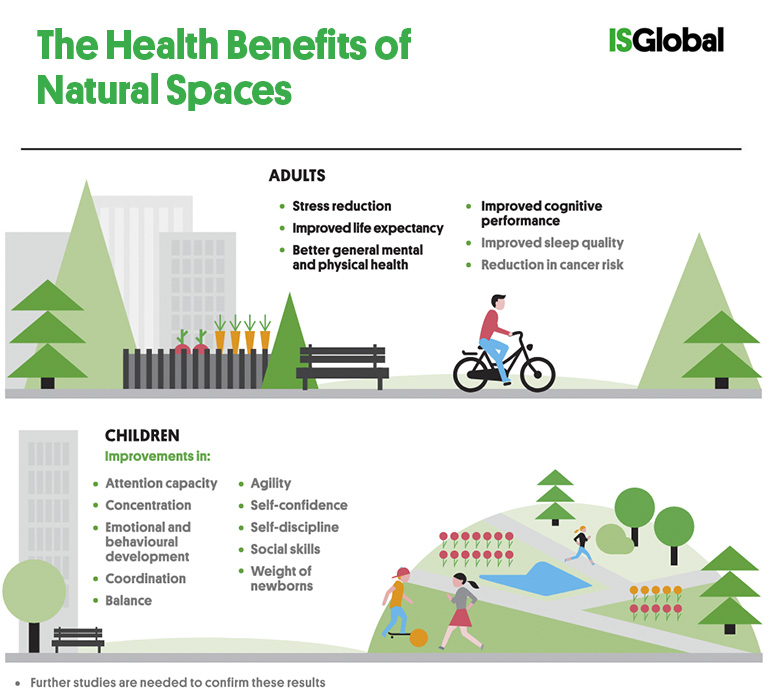Benefits of Green Spaces
Green spaces, such as parks, gardens, and forests, offer numerous benefits to individuals and communities. In this article, we will explore the various advantages of having green spaces in our surroundings. These benefits range from physical and mental health improvements to environmental sustainability and community well-being.
Improved Physical Health
Regular exposure to green spaces has been linked to improved physical health. Engaging in outdoor activities, such as walking, jogging, or playing sports in green areas, promotes cardiovascular fitness, reduces the risk of obesity, and enhances overall well-being. Green spaces provide opportunities for exercise and encourage a more active lifestyle.
Enhanced Mental Well-being
Spending time in green spaces has a positive impact on mental health and well-being. Research suggests that being in nature reduces stress levels, alleviates symptoms of anxiety and depression, and improves cognitive function. Green spaces offer a peaceful and serene environment, allowing individuals to relax, unwind, and rejuvenate.
Positive Environmental Impact
Green spaces play a crucial role in environmental sustainability. They help combat climate change by absorbing carbon dioxide and releasing oxygen through the process of photosynthesis. Trees and plants in green spaces act as natural air filters, purifying the air by trapping pollutants and reducing air pollution levels. Additionally, green spaces contribute to biodiversity conservation by providing habitats for various species of plants and animals.
Social and Community Benefits
Green spaces bring people together and foster a sense of community. They provide spaces for social interaction, recreational activities, and community events. Parks and gardens serve as meeting places for families, friends, and neighbors, promoting social cohesion and a sense of belonging. Well-maintained green spaces also enhance the aesthetic appeal of neighborhoods, making them more attractive and enjoyable places to live.
Economic Advantages
Green spaces offer economic benefits to communities. Properties located near green areas tend to have higher values and attract more potential buyers or renters. Access to green spaces can also boost tourism and support local businesses, such as cafes and recreational facilities. Well-designed and accessible green spaces contribute to the overall economic development and prosperity of a region.

In conclusion, green spaces provide a multitude of benefits to individuals, communities, and the environment. From physical health improvements and mental well-being enhancements to positive environmental impact and economic advantages, the presence of green spaces enriches our lives in numerous ways. It is essential to recognize the value of green spaces and prioritize their preservation and creation for the benefit of present and future generations.
Frequently Asked Questions – Benefits of Green Spaces
1. What are the benefits of green spaces?
Green spaces provide numerous benefits such as improved mental health, reduced stress levels, increased physical activity, and enhanced air quality.
2. How do green spaces contribute to improved mental health?
Spending time in green spaces has been shown to reduce symptoms of anxiety and depression, improve mood, and increase overall well-being.
3. Can green spaces help in reducing stress levels?
Yes, being in nature and surrounded by greenery has a calming effect on the mind and body, helping to lower stress levels and promote relaxation.
4. Do green spaces encourage physical activity?
Absolutely! Green spaces provide opportunities for outdoor activities like walking, jogging, cycling, and sports, which promote physical fitness and a healthy lifestyle.
5. How do green spaces contribute to improved air quality?
Trees and plants in green spaces absorb pollutants and release oxygen, thereby improving air quality and reducing the risk of respiratory problems.
6. Can green spaces help in reducing noise pollution?
Yes, green spaces act as natural buffers and absorb sound, helping to reduce noise pollution and create a more peaceful environment.
7. Do green spaces have a positive impact on biodiversity?
Absolutely! Green spaces provide habitats for various plant and animal species, promoting biodiversity and supporting ecosystems.
8. How do green spaces contribute to community well-being?
Green spaces serve as gathering places for communities, fostering social connections, promoting a sense of belonging, and improving overall community well-being.
9. Can green spaces enhance property values?
Studies have shown that properties located near green spaces tend to have higher values, as people appreciate the aesthetic appeal and recreational opportunities offered by these areas.
10. How can green spaces contribute to climate change mitigation?
Trees in green spaces absorb carbon dioxide, a greenhouse gas responsible for climate change, and help in reducing its concentration in the atmosphere, thus contributing to climate change mitigation.




